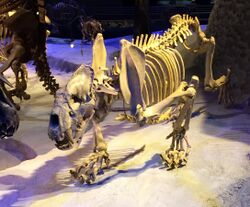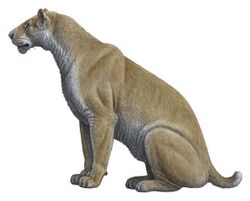Biology:Xenosmilus
| Xenosmilus | |
|---|---|

| |
| X. hodsonae, Florida Museum of Natural History Fossil Hall at the University of Florida | |
| Scientific classification | |
| Domain: | Eukaryota |
| Kingdom: | Animalia |
| Phylum: | Chordata |
| Class: | Mammalia |
| Order: | Carnivora |
| Suborder: | Feliformia |
| Family: | Felidae |
| Subfamily: | †Machairodontinae |
| Tribe: | †Homotherini |
| Genus: | †Xenosmilus Martin et al., 2000 |
| Type species | |
| †Xenosmilus hodsonae Martin et al., 2000
| |
Xenosmilus is an extinct genus of homotherin machairodontine (saber-toothed cat) that was discovered in Florida in 2001. It has one species, Xenosmilus hodsonae.
Discovery and naming
The new genus and species Xenosmilus hodsonae was described in 2001 based on a nearly complete skeleton (BIOPSI 101) from the Florida site Haile 21A, with a second partial skeleton (UF 60,000) as the paratype. Both skeletons came from Early Pleistocene-aged rocks in Florida.[1]
The genus name Xenosmilus was derived from the Greek ξένος/Script error: The function "transl" does not exist. meaning "strange", and σμίλη/Script error: The function "transl" does not exist. meaning "knife". The species name hodsonae honors Debra Hodson, the wife of a researcher.[1][2]
Description
Two fairly intact specimens were found by amateur fossil hunters in 1983 (1981 by some sources) in the Haile limestone mines in Alachua County, Florida. In 1994, the fossils were examined, and it was decided that the cats were of an entirely new genus.[3] The fossils were of Irvingtonian age (1.8 to 0.3 Ma).[4] Because the skeletons were found beside each other, some suspect Xenosmilus was a social mammal.[2] Found alongside the two skeletons were dozens of peccary bones. It seems likely, with their muscular builds, that X. hodsonae preyed upon peccaries.


Physically, the cat reached around 2 m (6.6 ft) long[5] with a highly muscular body and weighed around 300–350 kg (660–770 lb), making it similar in size to the fellow machairodonts Machairodus horribilis[6] and Amphimachairodus kabir. Only Smilodon populator was noticeably larger amongst the saber-toothed cats.,[5][7] its also been found in quarries dating to the end Blancan such as Inglis 1a and Haile 7g, dating it up to 2 million years ago.[8] The skull of Xenosmilus was 33 centimetres ([convert: unknown unit]) in length.[9]
Classification
Xenosmilus is in the tribe Homotherini in the subfamily Machairodontinae of the cat family.[1]
A paper published in 2022 proposed that Xenosmilus is a more derived member of the tribe Machairodontini (another name for Homotherini), and that Homotherium venezuelensis should be reassigned to Xenosmilus.[10]
Paleobiology
Before the discovery of Xenosmilus, all known saber-toothed cats fell into two general categories. Dirk toothed cats had long upper canines and stout legs. Scimitar toothed cats had only mildly elongated canines, and long legs. Xenosmilus broke these groupings by possessing both stout muscular legs and body, and short broad upper canines.[11] Unlike most other saber-toothed cats, all of Xenosmilus's teeth were serrated, not just its fangs and incisors. The way its top teeth were lined up also allowed Xenosmilus to concentrate its bite force on two teeth at a time.[2]
Xenosmilus has also been theorized by some to have hunted via a "bite and retreat" strategy using its teeth to inflict deep wounds because of the way its canines and incisors could operate as a unit during a bite, leading to Xenosmilus bearing the occasional moniker of "cookie-cutter cat".[12][3] Studies published in 2022 suggest that Xenosmilus and other machairodonts such as Smilodon were also capable of efficiently removing meat from a kill without damaging their teeth, as evidenced by bite marks on the bones of Platygonus. This same study also suggests that machairodonts could consume at least smaller bones when feeding, similar to lions.[13]
References
- ↑ 1.0 1.1 1.2 Martin, L. D.; Babiarz, J. P.; Naples, V. L.; Hearst, J. (2000). "Three Ways to be a Saber-Toothed Cat". Naturwissenschaften 87 (1): 41–44. doi:10.1007/s001140050007. PMID 10663132. Bibcode: 2000NW.....87...41M.
- ↑ 2.0 2.1 2.2 "Xenosmilus is the grittier name for "cookie-cutter panda cat"" (in en). 2019-12-19. https://coffeeandcreatures.co.uk/2019/12/19/xenosmilus-facts/.
- ↑ 3.0 3.1 "Cookie-Cutter Cat Not as Cute as the Name Sounds" (in en-US). Wired. ISSN 1059-1028. https://www.wired.com/2011/10/cookie-cutter-cat-not-as-cute-the-name-sounds/. Retrieved 2021-07-04.
- ↑ Xenosmilus in the Paleobiology Database
- ↑ 5.0 5.1 "Xenosmilus". https://ucmp.berkeley.edu/education/lessons/xenosmilus/xenosmilus.html.
- ↑ Giovanni G. Bellani (2019). Felines of the World. Discoveries in Taxonomic Classification and History. Elsevier Science. pp. 30–31. ISBN 9780128172773. https://books.google.com/books?id=xK2wDwAAQBAJ. Retrieved 19 September 2022.
- ↑ "Xenosmilus hodsonae" (in en-US). 2017-04-03. https://www.floridamuseum.ufl.edu/florida-vertebrate-fossils/species/xenosmilus-hodsonae/.
- ↑ Hulbert, Richard C (January 2010). "A new early Pleistocene tapir (Mammalia: Perissodactyla) from Florida, with a review of Blancan tapirs from the state". https://www.researchgate.net/publication/228401554. Retrieved 2022-11-10.
- ↑ Rincón, Ascanio; Prevosti, Francisco Juan; Parra, Gilberto E (2011). "New Saber-Toothed Cat Records (Felidae: Machairodontinae) for the Pleistocene of Venezuela, and the Great American Biotic Interchange". Journal of Vertebrate Paleontology 31 (2): 468–478. doi:10.1080/02724634.2011.550366. Bibcode: 2011JVPal..31..468R. https://www.researchgate.net/figure/Upper-tooth-row-and-cranial-measurement-comparisons-among-Homotheriini-in-mm_tbl1_254314670.
- ↑ Jiangzuo, Qigao; Werdelin, Lars; Sun, Yuanlin (2022-05-15). "A dwarf sabertooth cat (Felidae: Machairodontinae) from Shanxi, China, and the phylogeny of the sabertooth tribe Machairodontini" (in en). Quaternary Science Reviews 284: 107517. doi:10.1016/j.quascirev.2022.107517. ISSN 0277-3791. Bibcode: 2022QSRv..28407517J. https://www.sciencedirect.com/science/article/pii/S0277379122001482.
- ↑ "A more fearsome saber-toothed cat". October 20, 2008. https://www.sciencenews.org/article/more-fearsome-saber-toothed-cat.
- ↑ Anton, Mauricio (2013). Sabertooth.
- ↑ Domínguez-Rodrigo, Manuel; Egeland, Charles P.; Cobo-Sánchez, Lucía; Baquedano, Enrique; Hulbert, Richard C. (2022). "Sabertooth carcass consumption behavior and the dynamics of Pleistocene large carnivoran guilds". Scientific Reports 12 (1): 6045. doi:10.1038/s41598-022-09480-7. PMID 35501323. Bibcode: 2022NatSR..12.6045D.
- Martin, L.; Naples, V.; Babiarz, J. (2008). "COOKIE-CUTTER CATS: ANOTHER SABER-TOOTHED Morphotype". Journal of Vertebrate Paleontology 28 (3): 112A.
- Christiansen, Per (2011). "A dynamic model for the evolution of sabrecat predatory bite mechanics". Zoological Journal of the Linnean Society 162: 220–242. doi:10.1111/j.1096-3642.2010.00675.x.
- "The First South American Homotheriini". Comunicaciones Paleontologicas. https://www.mna.gub.uy/innovaportal/file/25910/1/cp35.pdf.
Wikidata ☰ {{{from}}} entry
 |

